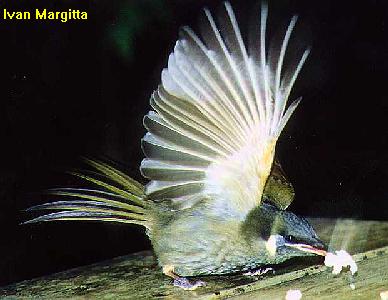The Birds In Backyards ProjectLandscapes dominated by human habitation support many species of birds, sometimes at high population densities. However, populations of small native birds in cities have noticeably declined since the 1950’s, often resulting in local extinctions. Concurrently, populations of some large native birds and some exotic bird species appear to have adapted successfully to human altered environments and have expanded considerably. People want to attract birds to their gardens but little information is available. Some of the potentially important factors determining which species co-exist with human settlement are the fragmentation of bushland, plant choices and garden designs, predation by exotic predators, supplementary feeding by humans, high levels of residual pesticides and other pollutants. The Project The Birds in Backyards Project is a Birds Australia Project initially being carried out in the greater Sydney, Hunter and Illawarra areas of New South Wales. The ultimate aim of the Birds in Backyards Project is the re-establishment of a diverse bird community in urban areas. This will be achieved through research into urban habitats, developing methods to improve bird habitat and encouraging widespread awareness and understanding within the community both of the need for change and the means by which that change can be implemented. There are three separate but interconnecting components of the Project – research, education and conservation. Research The Birds in Backyards research is structured as a series of interrelated modules. Each module is a discrete research project undertaken as a collaborative venture between a University and Birds in Backyards. Projects are designed for Honours, Masters or PhD studies and Birds in Backyards provides research funds and a stipend to attract an outstanding student and university supervisor. Birds Australia also provides a co-supervisor with expertise in the research field of each module.
The first of these modules commenced in July, 2000. Almost half the funds required for the second module which is due to commence in July, 2001 have now been received, predominantly from individual donations. However full funding for this module is still being sought. Education The education component of the Project aims to develop an awareness and understanding of the current status of urban birds and a “hands on” culture of birdscaping and monitoring of bird populations. The environmental education program will be aimed at all levels of the community through a range of education methods such as the development of an accredited teaching program to be used in schools, presentations and workshops with community groups, and development and distribution of informative publications. Conservation The conservation program aims to increase the diversity of urban avifauna. Practical models will be developed to actively encourage and promote the use of appropriate plants and planting designs, which will create habitat for birds and other wildlife. Municipal Councils and schools which are responsible for large tracts of open space will be encouraged to participate. The Project also intends to encourage the commercial development of a greater variety of endemic plants. In Summary Birds in Backyards plans to achieve the reintroduction of a diverse and dynamic bird community into urban areas by maximising educational and conservation opportunities within the broader community thus developing a “hands-on” culture of birdscaping and monitoring of bird populations. This will contribute to the creation of an environmentally pro-active, aware and responsible community. Funding In the long- term, after completion of the research program, a Birdscaping Advisory Service is planned together with informative publications. In this way it is hoped that Birds in Backyards will eventually become self-funding and be able to continue until its objectives are fully realised. Currently however, the project is seeking funding from the corporate sector and from individual donations. All donations contribute directly to the research grants being provided to university students. Donations over $2 to Birds Australia are tax deductible and should be send to: Birds in Backyards, For more information, contact Kate Ravich (kuindah@bigpond.com) or phone: 02 9436 0388. Updated by Kate Ravich from the journal of the Society for Growing Australian Plants (Canberra Region), June 2000.  [Front Page] [Features] [Departments] [Society Home] [Subscribe] Australian Plants online - September 2000 |


